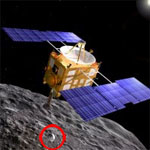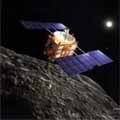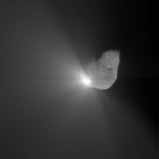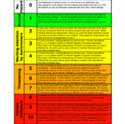Browse News
|
Stardust successfully returns comet material to Earth
16/01/06
|
|
|
A capsule containing cometary and interstellar material collected by the Stardust spacecraft successfully landed in Utah yesterday, becoming the first mission to return samples from beyond the Earth-Moon system.
Read the news item
|
Hayabusa's return to Earth postponed until 2010
14/12/05
|

|
|
The Japanese Space Agency will postpone the return to Earth flight of Hayabusa to 2010, after losing contact with the probe. The announcement came shortly the Agency learnt that the second asteroid sample collection probably failed.
Read the news item
|
Hayabusa collects asteroid sample
29/11/05
|

|
|
Hayabusa's second attempt to collect a sample from the surface of Itokawa was successful, making it the first spacecraft to collect asteroid material.
Read the news item
|
Japanese announce that Hayabusa did land on Itokawa
24/11/05
|
|
|
The Japanese space agency has announced that their spacecraft Hayabusa did in fact land on asteroid Itokawa on Saturday, but the equipment designed to collect a sample was not deployed.
Read the news item
|
First Hayabusa sample collection fails, but UK names are delivered to asteroid
21/11/05
|
|
|
The Japanese Hayabusa spacecraft failed in its first attempt to collect a sample of material from asteroid Itokawa. The target marker, containing an aluminium sheet with hundreds of UK names printed on, was successfully deployed to the surface.
Read the news item
|
UK names to land on asteroid
18/11/05
|

|
|
The names of hundreds of visitors of the National Space Centre are due to land on asteroid Itokawa on Saturday, when the Japanese Hayabusa spacecraft prepares to collect a sample of material.
Read the news item
|
Hayabusa lander misses target
14/11/05
|
|
|
Japan's Hayabusa mission to Itokawa has failed to land its MINERVA probe on the asteroid's surface. Hayabusa's main objective, to collect material from Itokawa's surface to return to Earth, is still planned for later this month.
Read the news item
|
New asteroid deflection method uses gravity as a towline
10/11/05
|
|
|
Two NASA astronauts have designed a spacecraft that could use gravity as a towline to change the course of asteroids. The technique could be used in the future to prevent asteroids striking the Earth.
Read the news item
|
Hayabusa probe approaches asteroid Itokawa
14/09/05
|

|
|
The Japanese Hayabusa spacecraft has arrived at a spot 20 kilometres above asteroid Itokawa, where it will hover for three months, collecting data. The probe will then collect a sample from the surface of the asteroid and return it to Earth for analysis.
Read the news item
|
Success as Deep Impact crashes into Tempel-1
04/07/05
|

|
|
NASA's Deep Impact spacecraft has successfully crashed its impactor into comet Tempel-1. Both ground and space-based telescopes watched the collision at around 6:50 BST, which threw up a huge plume of debris.
Read the news item
|
Mission to Near Earth Asteroid proposed
01/06/05
|
|
|
Former astronaut Russell Schweickart has outlined plans to send a radio transmitter to land on asteroid 2004 MN4. The asteroid will pass within the orbit of the Earth's geostationary satellites in 2029.
Read the news item
|
Cash injection for US Near Earth Asteroid research
01/06/05
|
|
|
A science committee in the US Congress has passed a bill to provide $40 million to NASA's search for Near Earth Asteroids. The money will be used to detect, track and study objects larger than 100 metres wide.
Read the news item
|
Revised Near Earth Object threat scale formally published
13/04/05
|

|
|
The Torino scale, used to rate threats from asteroids and comets, has been altered to better distinguish between objects that warrant further observations by astronomers and those warranting public concern.
Read the news item
|
Dinosaur-killing asteroid vaporised, forming mysterious layer
24/03/05
|
|
|
Recent research has led to a new theory about the formation of the residue left by an asteroid impact, 65 million years ago. The theory suggests the collision not only melted, but vaporised the rock, forming small droplets found in the residue.
Read the news item
|
Meteor Crater created by slower, fragmented object
11/03/05
|
|
|
A computer simulation has shown the object that caused the Meteor (Barringer) Crater in Arizona, 50 000 years ago, was fragmented and travelling much slower than previously thought.
Read the news item
|
More news stories
1,
2,
3,
4,
5,
6,
7,
8,
9,
10,
11,
12,
13,
14,
15,
16,
17,
18,
19,
20,
click to view more pages
|
|
|
National Space Centre,
Exploration Drive, Leicester, LE4 5NS, UK.
|